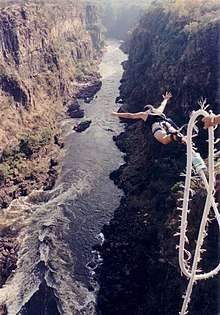Extreme tourism
Extreme tourism (also often referred to as shock tourism, although both concepts do not appear strictly similar) is a niche in the tourism industry involving travel to dangerous places (mountains, jungles, deserts, caves, canyons, etc.) or participation in dangerous events. Extreme tourism overlaps with extreme sport. The two share the main attraction, "adrenaline rush" caused by an element of risk, and differing mostly in the degree of engagement and professionalism.


While traditional tourism requires significant investments in hotels, roads, etc., extreme tourism requires much less to jump-start a business. In addition to traditional travel-based tourism destinations, various exotic attractions are suggested, such as flyovers in MiGs at Mach 2.5, ice diving in the White Sea, or travelling across the Chernobyl zone.
Some of the extreme famous attractions in the world:
- Chernobyl Tours – Ukraine.
- Swimming in the Devil's Pool in Victoria Falls – Zambia and Zimbabwe.
- Walking the Plank at Mount Hua – China.
- Death Road Tour – Bolivia.
- Green Zone – Baghdad, Iraq.
- Sac Actun tours – Riviera Maya, Mexico
- Cave of Swallows – Mexico
- Pole of Cold – Oymyakon, Yakutia, Siberia
See also
- Canoeing, Rafting, Scuba diving, Snorkeling, Boating
- Canyoning, River trekking
- Caving, Speleology
- Exploration
- Hypermobility (travel)
- Mountaineering, Skiing, Snowboarding, Speed riding
- Paragliding, Bungee jumping, Skydiving, Base jumping
- Storm chasing
- Trekking, Hiking, Via ferrata
- Urban exploration